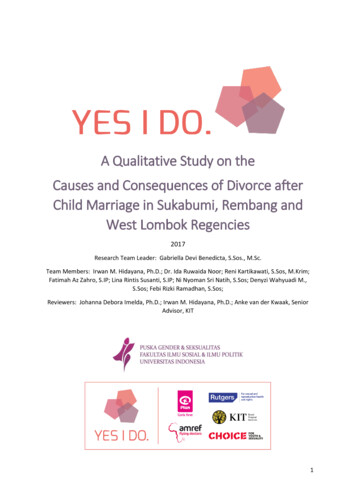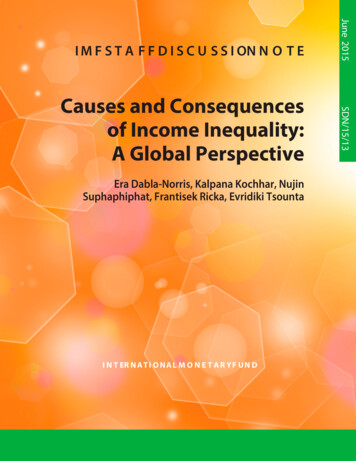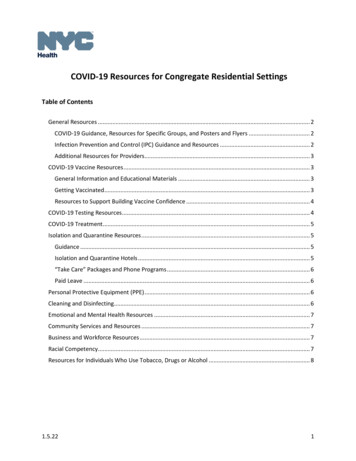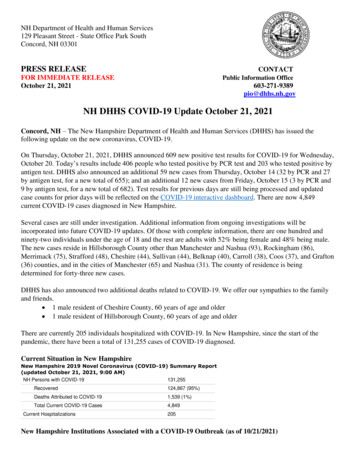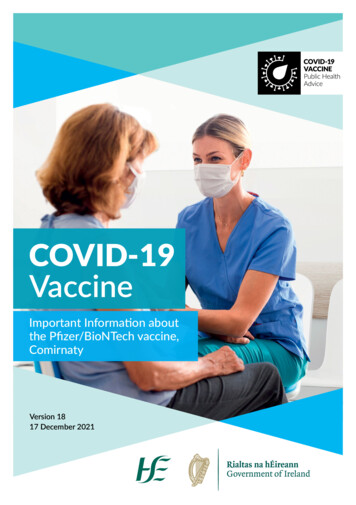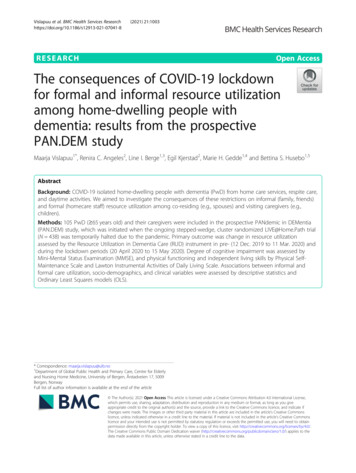
Transcription
Vislapuu et al. BMC Health Services (2021) 21:1003RESEARCHOpen AccessThe consequences of COVID-19 lockdownfor formal and informal resource utilizationamong home-dwelling people withdementia: results from the prospectivePAN.DEM studyMaarja Vislapuu1*, Renira C. Angeles2, Line I. Berge1,3, Egil Kjerstad2, Marie H. Gedde1,4 and Bettina S. Husebo1,5AbstractBackground: COVID-19 isolated home-dwelling people with dementia (PwD) from home care services, respite care,and daytime activities. We aimed to investigate the consequences of these restrictions on informal (family, friends)and formal (homecare staff) resource utilization among co-residing (e.g., spouses) and visiting caregivers (e.g.,children).Methods: 105 PwD ( 65 years old) and their caregivers were included in the prospective PANdemic in DEMentia(PAN.DEM) study, which was initiated when the ongoing stepped-wedge, cluster randomized LIVE@Home.Path trial(N 438) was temporarily halted due to the pandemic. Primary outcome was change in resource utilizationassessed by the Resource Utilization in Dementia Care (RUD) instrument in pre- (12 Dec. 2019 to 11 Mar. 2020) andduring the lockdown periods (20 April 2020 to 15 May 2020). Degree of cognitive impairment was assessed byMini-Mental Status Examination (MMSE), and physical functioning and independent living skills by Physical SelfMaintenance Scale and Lawton Instrumental Activities of Daily Living Scale. Associations between informal andformal care utilization, socio-demographics, and clinical variables were assessed by descriptive statistics andOrdinary Least Squares models (OLS).* Correspondence: maarja.vislapuu@uib.no1Department of Global Public Health and Primary Care, Centre for Elderlyand Nursing Home Medicine, University of Bergen, Årstadveien 17, 5009Bergen, NorwayFull list of author information is available at the end of the article The Author(s). 2021 Open Access This article is licensed under a Creative Commons Attribution 4.0 International License,which permits use, sharing, adaptation, distribution and reproduction in any medium or format, as long as you giveappropriate credit to the original author(s) and the source, provide a link to the Creative Commons licence, and indicate ifchanges were made. The images or other third party material in this article are included in the article's Creative Commonslicence, unless indicated otherwise in a credit line to the material. If material is not included in the article's Creative Commonslicence and your intended use is not permitted by statutory regulation or exceeds the permitted use, you will need to obtainpermission directly from the copyright holder. To view a copy of this licence, visit http://creativecommons.org/licenses/by/4.0/.The Creative Commons Public Domain Dedication waiver ) applies to thedata made available in this article, unless otherwise stated in a credit line to the data.
Vislapuu et al. BMC Health Services Research(2021) 21:1003Page 2 of 12Results: Mean age for PwD was 81.8 years; 61% were female; 45.6% lived alone, and the mean MMSE score was20.8 (SD 3.7). PwD with co-residents (44%) were younger (78.4 years) than those who were living alone (84.5 years;P 0.001). During the first 2 months of lockdown, PwD missed on average 20.5 h of formal care in a month (P 0.001) leading to an approximately 100% increase in informal care, which was particularly pronounced in personalhygiene (6.9 vs. 11.4 days in a month, P 0.001) and supervision (9.2 vs. 17.6 days in a month; P 0.001). Visitingcaregivers increased by 1.9 days (SD 11.5), but co-residing caregivers increased their number of days providingADL by approximately 7 days per month (β 6.9; CI, 0.39–13.1, P 0.05) after adjusting for PwD and caregiverdemographics and clinical variables. Decrease in home nursing care was particularly visible for PwD living alone ( 6.1 vs. -1.3 h per month, P 0.005). Higher cognitive function (β 0.64, CI, 1.26 – 0.02, P 0.044) was associatedwith reduction in home nursing service during the lockdown.Conclusion: The care situation for PwD changed dramatically in the early phase of the COVID-19 pandemic, especiallyfor those living alone who received less support from homecare services and visiting caregivers. For future crises andthe forthcoming post-pandemic period, health authorities must plan better and identify and prioritize those in greatestneed.Trial registration: ClinicalTrials.gov; NCT04043364.Keywords: COVID-19, Dementia, Caregiver, Resource utilization, Formal care, Informal careBackgroundHealth systems must be able to adapt effectively to changing conditions with limited resources. Early on in theCOVID-19 pandemic, one of society’s most pressing issues became the provision of adequate care and treatment for home-dwelling people with dementia (PwD).To protect the lives of older adults, a restrictive policywas rigorously implemented by the Norwegian government and all municipal-based services such as daycare,respite care, and even daily homecare support wereclosed (as of 12 March 2020) [1, 2].Countries worldwide adopted different lockdown policies. The U. K and Sweden, implemented a “shielding policy” (people in vulnerable groups were asked to stay athome),to protect the elderly over 70 years of age [3–5].China, Norway and Germany, implemented social distancing measures for the entire population [4–6]. InGermany during the lockdown, incident diagnoses decreased 17–26% among 2.45 million older patients, including those with a dementia diagnosis [6]. This isconcerning as dementia diagnosis is a prerequisite fordementia-tailored home-based care services [7]. A UKstudy (n 14,891) showed individuals with chronic illnesses to be twice as likely to cancel their health care appointments than the general population. They were alsotwice as likely to need increased care hours. Authors suggest that a significant proportion of people having one ormore chronical illnesses were deprived of essential careduring the lockdown [8].In Norway, 101,000 people (1.9% of the population)have dementia [9], of whom 70,000 (69%) are living athome and provided with treatment and care by formalhomecare services and informal caregivers; the latter areoften co-residing (e.g., spouses) or visiting (e.g., children).To support older adults staying safely, independently, andfor a longer time in their own homes, the Norwegian welfare state administers social and care services by the municipalities [10]. This work includes medication aid, wounddressing, help with personal hygiene, and social, physical,and mental activities outside the home. These services areoffered to about 50% of home-dwelling PwD [11].The service disruption during COVID-19 raises concerns about the direct consequences for PwD and theircaregivers, because social distancing and isolation may decrease self-care ability and exacerbate informal caregiverburden and stress, as well as worsen the behavioral andpsychological symptoms of dementia (BPSD) such as agitation, anxiety and psychosis [12–15]. A UK crosssectional survey of COVID-19 related social support closures and their effects on 569 participants indicates thatthe reduction in formal service hours increased levels ofanxiety in older people and PwD and in addition, themental well-being of informal caregivers was reduced [16].Other authors suggest that the pandemic requires evenmore informal caregiving compared to the pre-pandemicburden, and previous research has shown that coresidency is a common denominator for the scope of informal care utilization and high caregiver burden [17, 18].However, none of these studies have investigated the relationship between formal and informal care during thepandemic-induced reductions in formal services. Clearlythere is a need for more investigation about the consequences of COVID-19 for different caregiver groups.To investigate how COVID-19 affected the lives ofhome-dwelling PwD and their caregivers, our researchgroup initiated the prospective PAN.DEM study nestedwithin the ongoing trial LIVE@Home.Path [19, 20]. Thisstudy aimed to investigate the consequences of the initial
Vislapuu et al. BMC Health Services Research(2021) 21:1003phase of COVID-19 restrictions on informal and formalresource utilization among co-residing and visiting caregivers. We hypothesize that 1) the ratio of formal vs. informal care changed during the COVID-19 lockdown,with an increase in informal care; 2) the provision of informal care increased more among co-residing caregivers compared to visiting caregivers; 3) theprioritization of formal care services changed in order tosupport alone living PwD to compensate for decreasedfamily support.MethodsPage 3 of 12To investigate how the pandemic affected the dyads, ourresearch group initiated the prospective PAN.DEM cohortstudy consecutively including caregivers by semistructured telephone interviews from 20 April 2020 to 15May 2020 [19]. Pre- lockdown data was collected in between 12 December 2019 and 11 March 2020. PAN.DEMcontained core assessment instruments from LIVE@Home.Path in addition to questions about how the lockdownaffected the dyads’ everyday life [19]. Data were collectedusing tablet computers and stored securely on the internaldata server at the University of Bergen, Norway, to ensuredata privacy and quality.Participants and enrolmentLIVE@Home.Path is a 24-month, stepped wedge randomized controlled trial for home-dwelling PwD andtheir informal caregivers (dyads) to investigate the effectof a multicomponent LIVE intervention on resourceutilization in municipal dementia care (tentative studyperiod May 2019 – April 2021). LIVE is the acronym forthe intervention comprising Learning, Innovation, Volunteers, and Empowerment [20]. Home-dwelling PwDwere eligible for inclusion if they were 65 years old, diagnosed with dementia according to the standardizedprotocol, a Mini-Mental Status Examination (MMSE)score 15–26 [21] or a Functional Assessment Stagingscale (FAST) score 3–7 [22], lived together with an informal caregiver (co-residing), or physically meetingfamily members/friends at least once a week (visiting)[19]. The stepped wedge design implies that all dyadswill receive the 6 months intervention, but the timing isdetermined by randomization (Fig. 1).The COVID-19 restrictions temporarily halted the implementation of the intervention in the LIVE@Home.Path.MeasurementsThe primary outcome of this study was the change informal and informal caregiving as assessed by The Resource Utilization in Dementia (RUD), which is a measurement developed by Wimo et al. [23] that assesses thefrequency and number of hours during the last 30 daysspent on informal care in supervision, including assistingbasic self-care tasks (ADL) and instrumental tasks(IADL) that require more extensive planning skills. ADLincludes assistance with functional mobility, toileting,bathing, hygiene, and eating. IADL includes care taskssuch as shopping for groceries, preparing meals, undertaking household chores, and doing laundry [23]. Inaddition to informal care, RUD also measures the frequency and number of hours of formal care during thelast 30 days (home nursing, home help, meals on wheels,transportation, and daycare). The instrument is validatedfor the assessment of resource utilization in nursinghomes and for home-dwelling PwD [23–25]. To measurethe change in pre- and post-pandemic regulationFig. 1 The LIVE@Home.Path trial timeline, including Pandemic in Dementia (PAN.DEM) study
Vislapuu et al. BMC Health Services Research(2021) 21:1003outcomes, we divided the caregivers according to theirliving status (co-residing or visiting).CovariatesTo investigate the potential changes of informal care before and after lockdown among co-residing and visitingcaregivers and informal care use, we included caregiverdemographics (age, gender, level of education, and employment status). In addition, we measured cognitive impairment by MMSE (score range 0–30): a score 23indicates considerable cognitive impairment [26]. Instrumental Activities of Daily Living Scale (IADL) was usedto assess the level of functioning [27] and the PhysicalSelf-Maintenance Scale (PSMS) was used for the level ofphysical self-care [28]. For both IADL (range 8–31) andPSMS (range 6–30), higher scores indicate reduced ability to self-care in activities of daily living [27, 28]. Theclinical global impressions of change (CGIC) was usedto assess the perceived change in the total situation bythe primary caregiver during the lockdown [29], with thecaregivers’ answers trichotomized to improved/worsened/no change.Statistical analysisDescriptive statistics were presented by mean, standarddeviation (SD) and frequencies (%). To consider normality in the continuous variables, histograms and QQ plotswere used as a first approach in addition to the ShapiroWilk test [30]. Differences between caregivers groupswere evaluated by the Mann-Whitney U test for nonnormally distributed continuous variables, and Pearsonχ2 tests for categorical variables. Welch’s unequal variance t-test was used to compare the change in formaland informal care utilization between groups of caregivers. Wilcoxon Signed-Rank test was used to comparechange between time use in pre- and lockdown periodin single samples. Missing data in descriptive statisticswas handled by pairwise deletion.Due to the structure of our data, ordinary least squares(OLS) regression was used to examine the associationbetween the change in informal care frequency and residency of caregiver – before and after the lockdown. Weused an interaction term between a time dummy indicating the value 0 and 1 for pre- and post-lockdown outcome, and a dummy for co-residency, thus comparingco-residential caregiver*lockdown to visiting caregiver*pre-lockdown. We used the Akaike information criterion (AIC) to determine the best-fit model within therange of included covariates. As caregivers and PwDs arenested within municipalities (n 3), we included municipalities as dummy variables to control of time-invarianteffects. Finally, we checked the main model for robustness to exclude the possibility of autocorrelation. The βcoefficient of statistically significant covariates arePage 4 of 12presented with 95% confidence intervals (CIs). All testswere two-sided, and a P-value 0.05 was considered statistically significant. The data were analyzed with Stata/SE, 16 (Stata, College Station, TX).Results438 dyads were assessed for eligibility to participate inthe LIVE@Home.Path trial. Of these, 158 were excludedbecause of institutionalization (n 17), not meeting theinclusion criteria (n 81), or lack of consent (n 60). InMay 2019, 280 dyads were enrolled in the study, andafter 6 months, 237 completed the pre-lockdown assessment, of which 126 dyads were included in the subsequent PAN.DEM study. We excluded 21 dyads from ouranalyses because their pre-lockdown assessment wascompleted after the COVID-19 restrictions were effectuated. In total, there was a resulting study sample of 105dyads (Fig. 2).The mean age of the PwD was 81.8 years (SD 6.9);61% were female; 45.6% lived alone; the majority hadmild or moderate degrees of dementia (mean MMSEscore 20.8, SD 3.7) (Table 1). PwD co-residing with informal caregivers (N 46, 43.8%) were younger (78.4years, SD 6.0) than those living alone (84.5, SD 6.4,P 0.001).The mean age of the informal caregivers was 65.5 years(SD 12.1); 65.7% were female; 48.3% were co-residingwith the PwD. Of caregivers, 56% were children and41.6% were spouses; 66% considered themselves to bethe primary caregiver (Table 1). The mean age for coresiding caregivers was 74.6 years (SD 9.8), while themean age for visiting caregivers was 58.3 years (SD 8.4,P 0.001). More caregivers in both groups were female(co-residing 67.4%, visiting caregivers 64.4%).The change in formal and informal care from prelockdown to lockdownAs assessed by CGIC, the caregiver situation before versus after lockdown worsened for 67.6% of a PwD’s relatives; 27.6% reported no change in their condition; 4.8%reported improvement (Table 2). During lockdown, nineinformal caregivers were laid off from their employment.60% of the caregivers reported that the pandemic hadconsequences for formal care services and that supportwas reduced or not delivered at all by municipalities orhospitals (e.g., daycare, tour groups, respite services, andoutpatient appointments at hospitals). In addition, 22%of caregivers reported that they had delayed or cancelledservices for the PwD due to the pandemic.Table 3 shows a significant change in the number ofusers and average hours of formal caregiving when thepre-lockdown numbers are compared to lockdown numbers, with a reduction from 23.7 h per month (SD 29.6)to 3.6 h per month (SD 10.0). The number of PwD
Vislapuu et al. BMC Health Services Research(2021) 21:1003Page 5 of 12Fig. 2 Study design and participant flowreceiving home nursing decreased from 65.7 to 34.3%(P 0.001), corresponding to a reduction of 4.2 h permonth (SD 10.3). Home help (e.g., doing laundry andcleaning) was reduced from 38 to 18% of the PwD representing a loss of 0.5 h per month (SD 2.0, P 0.011),and daycare centers were closed for all participants (40.0to 0%; 15.5, SD 25.8, P 0.001). The overall informalcare increased in ADL (6.9 vs. 11.4 days/month, P 0.001) and supervision (9.2 vs. 17.6 days/month, P 0.001).Table 4 presents formal and informal care change bycomparing pre-lockdown and lockdown by residency ofcaregiver groups. Both groups showed a significant decrease in home nursing (P 0.002 and 0.001) and daycare (P 0.001), and an increase in informal supervisiontime (P 0.004 and 0.001). PwD supported by visitingcaregivers lost more home nursing care hours (6.1 h permonth) than PwD who were co-residing (1.3 h permonth, P 0.005). Informal care increased more in theco-residing group compared to the visiting group ( 7.8days/month vs. 1.9 days/month, P 0.035).The change in informal care comparing pre-lockdownwith lockdown by caregiver characteristicsTable 5 presents the OLS regression. The baseline model[1] shows that the lockdown led to an increase in ADLinformal care. Visiting caregivers increased by 1.9 days(SD 11.5), but co-residing caregivers increased theirnumber of days providing ADL by approximately 7 daysper month (β 6.9; CI, 0.39–13.1, P 0.05) after adjusting for PwD and caregiver demographics (age, gender)and clinical variables (BPSD, MMSE, and ADL functioning). We extended model 1 by including the variableadditional caregivers (model 2). This variable counts
Vislapuu et al. BMC Health Services Research(2021) 21:1003Page 6 of 12Table 1 Pre-lockdown characteristics for caregivers and people with dementia, by residency; (N 105)VariablesAll(n 105)Co-residing caregivers(n 46)Visiting caregivers(n 59)Difference, p-valueaMissing data(n)PwD characteristicsAge, mean (SD)81.8 (6.9)78.4 (6.0)84.5 (6.4) 0.001–Gender, female, n (%)64 (61)17 (37.0)47 (79.7) 0.001–Living alone, yes, n (%)47 (45.6)0 (0)47 (79.7) 0.0012MMSE, mean (SD)20.8 (3.7)20.8 (3.4)20.7 (3.6)0.8964IADL, mean (SD)21.8 (5.1)22.3 (5.2)21.4 (5.1)0.4111PSMS, mean (SD)11.7 (3.6)11.6 (4.0)11.8 (3.3)0.4992–Caregivers characteristicsAge, mean (SD)65.5 (12.1)74.6 (9.8)58.3 (8.4) 0.001Gender, female, n (%)69 (65.7)31 (67.4)38 (64.4)0.749–Higher education, yes, n (%)67 (63.8)28 (62.2)39 (68.4)0.513348 (45.7)4 (91.3)44 (74.6)Working, yes, n (%)Number of additional care providers, n (%)- 0 (no additional)17 (16.2)10 (21.7)7 (11.9)- 1 (one or more additional caregivers)88 (83.8)36 (78.3)52 (88.1)Relationship, n (%)- Spouse44 (41.9)42 (91.3)2 (3.4)- Child59 (56.2)4 (8.7)55 (93.2)- Other2 (1.9)–2 (3.4)- 1–20%2 (1.9)–2 (3.4)- 21–40%7 (6.7)–7 (11.9)- 41–60%16 (15.2)2 (4.4)14 (23.7)- 61–80%14 (13.3)1 (2.2)13 (22.0)- 81–100%66 (62.9)43 (93.5)23 (39.0)Primary caregivers’ contribution, n (%) 0.001–0.173– 0.001– 0.001–N total sample, n number of participantsData are mean (SD) and number (%)aTested with The Mann-Whitney U test for nonnormally distributed continuous variables, and Pearson χ2 tests for categorical variables; MMSE MiniMental Status Examination (range 0–30), higher scores indicate better cognition, IADL Instrumental Activities of Daily Living Scale (range 8–31), lowerscores indicate better functioning, PSMS Physical Self-Maintenance Scale (range 6–30), lower scores indicate better functioningTable 2 Experience during the lockdown for the 105 dyads, reported by the caregiversDifference, pvalueaAll(n 105)Co-residingcaregivers(n 46)Visitingcaregivers(n 59)Have health care services been influenced by pandemic, yes63(60.2)27 (58.7)36 (61.0)0.810–Have you or person with dementia self-canceled servicesb, yes21(22.1)9 (21.4)12 (22.6)0.88710Are you temporarily laid off due to the COVID-19 restrictions, yes9 (8.6)2 (4.35)7 (11.86) 0.001–0.600–The overall situation compared to immediately before thepandemic to lockdown:- Worse71(67.6)15 (32.6)42 (71.2)- Better5 (4.8)2 (4.4)3 (5.1)- No change29(27.6)15 (32.6)14 (23.7)Results are presented in n (%)aTested with The Mann-Whitney U test for nonnormally distributed continuous variables and Pearson χ2 tests for categorical variablesbIncludes primary and secondary health care servicesMissingdata(n)
Vislapuu et al. BMC Health Services Research(2021) 21:1003Page 7 of 12Table 3 Formal health care service utilization and the provision of informal care for the total sample before and during thelockdown, N 105Difference, pvalueaFormal careNumber of users prelockdown, yesn (%)Hrs/mthMean(SD)Number of users during thelockdown, yesn (%)Hrs/mthMean(SD)Home nursing69 (65.7)7.4(10.8)36 (34.3)3.3 (9.6) 4.2 (10.3) 0.001Home help38 (36.2)0.8 (1.9) 18 (17.1)0.3 (0.9) 0.5 (2.0)0.011Daycare center42 (40.0)15.5(25.8)0– 15.5 (25.8) 0.001Food delivery8 (7.6)NA6 (5.7)NANA0.881Transportation (carerelated)21 (20)NA0NANA 0.001Totalb80 (76.2)23.7(29.6)38 (36.2)3.6(10.0) 20.5 (29.0) 0.001Days/mthMean(SD)Mean change (SD),days/mthInformal careDays/mthMean(SD)Mean change (SD),hrs/mthIADLc101 (96.2)18.0(12.0)97 (92.4)17.4(12.1) 0.6 (11.5)0.058ADLd39 (37.1)6.9(11.3)52 (49.5)11.4(13.7)4.5 (13.7) 0.001Supervisione42 (40)9.2(13.0)76 (72.4)17.6(13.5)8.4 (16.1) 0.001N total sample, n number of patientsaPaired sample t-testbHome nursing, home help and daycare centercincludes care tasks like taking medicine, grocery shopping, and doing administrative tasksdincludes care tasks like toileting, hygiene, and eatingeincludes supervision in daily tasks and preventing dangerous situations, also calling to ensure well-beingNA – Not applicableadditional caregivers to the primary caregiver who is either co-residing or visiting PwD. In model 2 the interaction term still holds, with a small reduction in the betacoefficient (β 6.6, CI, 0.36-12.93, P 0.05). Inmodel 3 we included a robustness test to correct forautocorrelation. The interaction term remains unchanged (β 6.8, CI, 0.16-13.54, P 0.05).In addition to the main estimations in Table 5, we ranOLS regression by transforming our dependent variablefrom levels to differences. Multivariate regressionTable 4 Formal and informal care use before and during the lockdown by residency of caregivers (N 105)Co-residing caregivers(n 46)Pre- lockdownP-valueaVisiting caregivers(n 59)LockdownP-valuebPre- lockdownLockdownP-valueb0.8 (3.1)0.00211.7 (12.4)5.3 (12.1) 0.001Formal care hours in a monthHome nursing2.0 (4.3)0.005Home help0.4 (1.3)0.01 (0.3)0.2351.1 (2.3)0.5 (1.1) 0.0010.287Daycare15.1 (25.6)0 0.00115.8 (26.2)0 0.0010.879Total formal care17.4 (26.5)0.8 (3.3) 0.00128.6 (31.1)5.8 (12.7) 0.0010.265Informal care days in a monthIADL26.6 (8.9)27.4 (7.5)0.96211.3 (9.6)9.5 (8.7)0.4120.280ADL10.3 (13.8)18.1 (14.1)0.0504.3 (8.1)6.2 (10.9)0.3220.035Supervision13.0 (14.8)20.9 (13.4)0.0046.2 (10.6)15.0 (13.1)0.0010.773N total sample, n number of patients, IADL Instrumental Activities of Daily Living, ADL Basic Activities of Daily LivingaWelch’s unequal variance t-test was used to compare the change between caregiver groups by residencybWilcoxon Signed-Rank test was used to compare change between time use in pre- and lockdown period
Vislapuu et al. BMC Health Services Research(2021) 21:1003Page 8 of 12Table 5 OLS regressions of the number of informal days after the lockdown, N 105CovariatesModel 1Coef. 95% CIlowerModel 2Model 395% CIupperPCoef. 95% CIlower95% CIupperPCoef. 95% CIlower95% CIupperPTimeLockdowna0.86 3.385.100.6901.08 3.055.210.605.86 2.674.390.6321.55 4.817.910.6310.51 5.716.730.8711.55 5.628.720.6700.360.16Living SituationCo-residingbInteraction: time##co-residencycCo-residingb6.8513.310.038 6.6412.930.038 6.8513.540.045PwD age 0.20 0.490.090.167 0.19 0.470.080.168 0.20 0.500.100.195CG age0.15 0.080.380.2000.16 0.060.380.1550.15 0.090.390.225 2.64 6.691.400.199 2.03 5.981.930.314 2.64 6.551.260.184 1.01 4.832.820.605 1.52 5.262.220.422 1.00 4.812.800.603 2.52 7.652.600.333 1.24 6.293.800.628 2.52 6.991.930.265 0.18 0.350.010.052 0.14 0.310.030.115 0.17 0.29 0.060.003 0.31 0.780.170.203 0.38 0.850.080.109 0.30 0.790.170.2050.39PwD genderFemaledCg genderFemaledCG WorkingNodHealth care servicesHome nursingserviceClinical variablesMMSEfgPSMS0.790.091.500.026 0.981.660.006 0.770.151.440.016IADLh0.15 0.37.670.571 0.02 0.530.490.9440.15 0.360.660.561 1.90 5.932.110.352 2.83 7.461.790.229 8.05 15.29 0.810.0290.29MunicipalityiBergen 2.83 6.931.260.174Baerum 8.05 20.184.080.192Additional CGj 6.42 18.275.430.286 7.45 11.91 2.990.001–AIC1489.931480.431480.433Prob F 0.001 0.001 0.001R-squared0.2930.3330.293CG caregiver, PwD Person with dementia, CI Confidence Interval, applying Ordinary Least Square (OLS) analysis. Model (1) includes the main effect of thelockdown on the informal resource use in days on personal hygiene (ADL) in the last month. Model (2) an extended model, by including multiple caregivers.Model (3) robustness test for core coefficients. *p .05; **p .01aNational lockdown in Norway came into force 12th of March 2020, reference: pre-lockdown periodbReference: visiting caregivercInteraction term as “visiting##pre-pandemic” and “co-resident##pandemic”dReference: maleeReference: caregivers who were working when lockdown came into forcefMMSE – Mini-Mental Status Examination, at the trial inclusion (range 0–30)gPSMS - Physical Self-Maintenance Scale (range 6–30)hInstrumental Activities of Daily Living Scale (range 8–31)iReference: Kristiansand municipalityjReference: no additional caregiversanalysis presented in table A1 suggests that lower IADLfunction (β 2.51, CI, 4.32 - -0.69, P 0.007) andhigher cognitive function (β 0.64, CI, 1.26 – 0.02,P 0.044) were associated with formal care reductionduring the lockdown. Thus, as the main estimations andthe additional OLS regressions showed, demographicvariables of both PwD and caregivers are not significantwhen determining formal and informal care after lockdown implementations. In contrast, we see that coresidency, as well as clinical variables such as MMSE arecrucial factors in determining access to care duringlockdown.
Vislapuu et al. BMC Health Services Research(2021) 21:1003DiscussionThe aim of this prospective was investigate the immediate consequences of the COVID-19 lockdown on resource utilization among home-dwelling PwD inNorway. As expected, the ratio between formal and informal caregiving changed significantly during the restrictions. Regardless of their living situation, almost70% of relatives of a PwD reported an increase in theircare responsibilities. The results also confirm that informal care provision is dissimilar across various groups ofcaregivers and co-residing relatives provided more carethan visiting caregivers, especially in personal hygienetasks. However, formal homecare services did not identify and prioritize PwD who were living alone. These individuals received both less formal and informal carecompared to those who lived in a family setting. Thelack of prioritization may widen the gap between thosewho have more care support and those who have less.This observation can be thought of as example of “theMatthew effect”, which refers to the idea that both advantages and disadvantages tend to accumulate, whichin this case results in continuously widening differencesin living situations. These findings are of key importancefor stakeholders and policymakers so that they can better plan support for home-dwelling PwD in the upcoming post-pandemic period and in future crises. Not onlydoes society benefit from better planning, but becausedementia can strike anyone, we as individuals might alsobenefit from well-planned, dementia-friendly independent and safe living at home when we get older.Co-residing caregivers (mostly spouses) are particularly affected and prone to care overburden by thepandemic lockdown and the sudden disruption in formal care. In our study, 22% of PwD or their caregivers self-cancelled municipal care services. Reasonsfor this reaction may be found in a study by Westet al. [31], which qualitatively explored effects of theCOVID-19 pandemic on PwD (N 15) and their family caregivers in the black, Asian and minority ethnic(BAME) communities in the UK. The study identifiedeight themes (fear and anxiety, food and eating, isolation and identity, and community and social relationships) that were most pertinent to their experiencesof community dementia care and COVID-19’s impacton their daily lives. A study from Israel by Werneret al. [32] demonstrates that co-residing with PwD,feelings of burden and low income level were the factors associated with caregivers’ forgone care fromgeneral practitioners and medical specialists. Fear andanxiety (in the form of a desire to avoid infection)may have contribute
formal care utilization and high caregiver burden [17, 18]. However, none of these studies have investigated the rela-tionship between formal and informal care during the pandemic-induced reductions in formal services. Clearly there is a need for more investigation about the conse-quences of COVID-19 for different caregiver groups.




